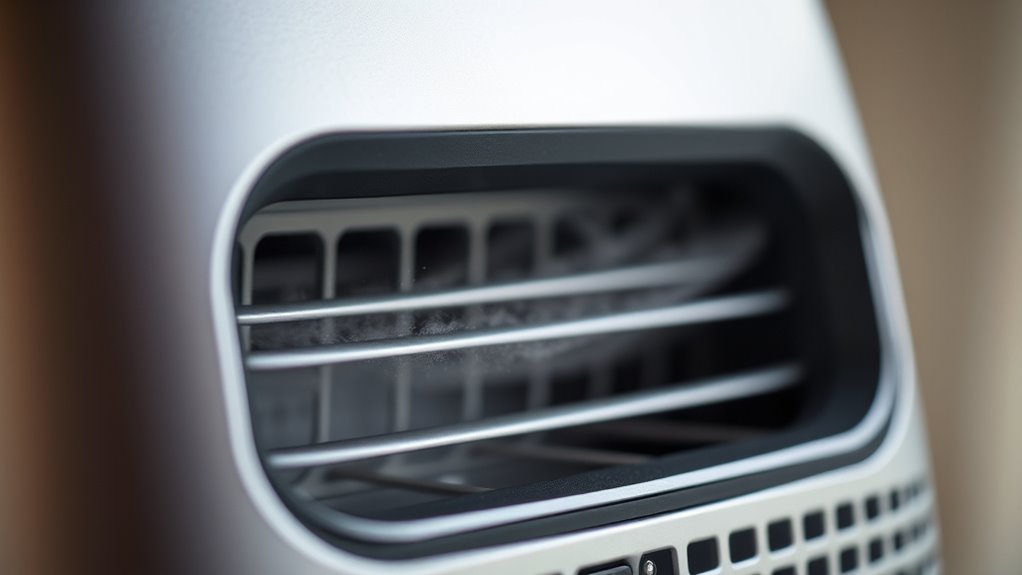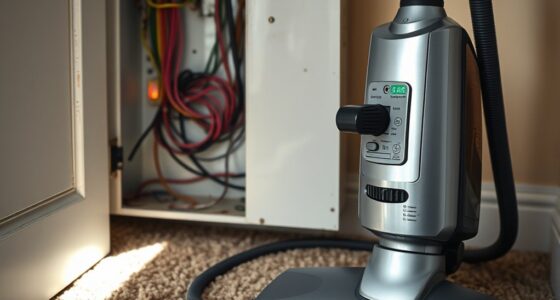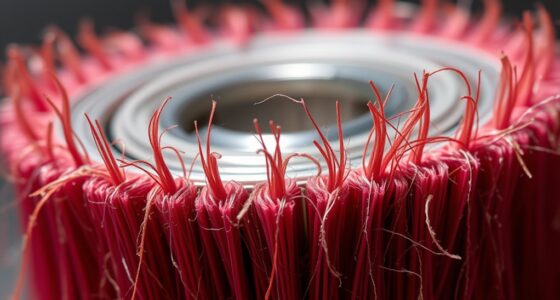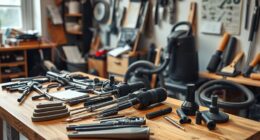If you’re dealing with high-pitched squeals, start by inspecting airflow paths and seals. Worn or loose seals can cause airflow disturbances that lead to noise, so replace any damaged seals quickly. Check for loose components or misaligned parts like fan blades or belts, as these can generate vibrations. Regular maintenance and vibration analysis help catch issues early. Keep investigating these problems, and you’ll discover how to minimize noise and improve your equipment’s performance.
Key Takeaways
- Inspect and replace worn or damaged seals to prevent airflow disturbances causing squeals.
- Use vibration analysis to identify loose or misaligned components generating high-frequency noises.
- Regularly maintain seals and check for cracks or wear to ensure smooth airflow and reduce squealing.
- Implement routine maintenance and monitoring to detect early airflow or seal issues before they worsen.
- Consider AI diagnostics and advanced tools for precise identification and prompt resolution of airflow and seal problems.
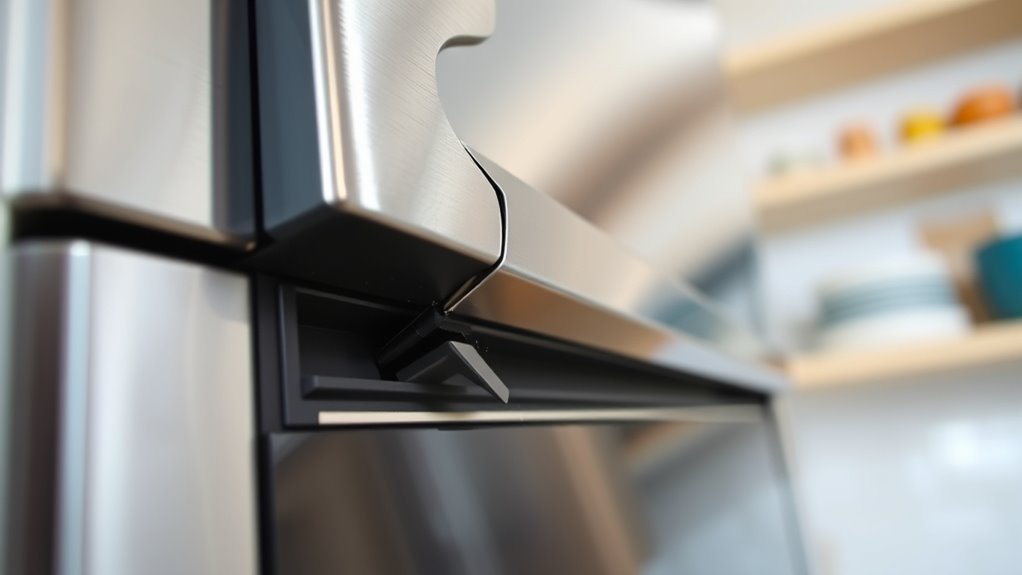
High-pitched squeals can be incredibly annoying and disruptive, especially when they occur unexpectedly. If you’re noticing these high-frequency noises, chances are that your equipment or appliances are experiencing airflow or seal issues. Addressing these problems quickly can save you from more costly repairs down the line and guarantee your environment remains comfortable and quiet. One of the most effective ways to diagnose and fix these squeals is through vibration analysis. This technique allows you to detect abnormal vibrations within machinery, which often point to loose or worn-out components causing airflow disruptions. When equipment vibrates excessively, it can create high-pitched sounds that are both irritating and a sign of underlying issues. Using vibration analysis tools, you can pinpoint exactly where the problem lies, whether it’s a misaligned fan blade, a loose belt, or a failing bearing. Once identified, you can take targeted action to tighten, replace, or realign parts, preventing the squeal from recurring.
Another essential aspect in tackling high-pitched squeals involves proper seal maintenance. Seals play a critical role in controlling airflow within machines and preventing leaks. Over time, seals can degrade or become damaged, leading to airflow disturbances that generate high-frequency noises. Regular inspection and maintenance of seals ensure they remain intact and effectively perform their function. If you notice any cracks, hardened rubber, or signs of wear, it’s essential to replace the seals promptly. Proper seal maintenance not only reduces noise but also improves the overall efficiency of your equipment by preventing leaks that could cause additional strain on motors or fans. When seals are in good condition, airflow remains smooth and consistent, which greatly reduces squeals and other noise issues. Incorporating AI-driven diagnostics and vibration analysis enhances your ability to detect issues early and maintain optimal equipment performance.
Incorporating vibration analysis and seal maintenance into your routine checks helps you stay ahead of potential problems. It’s a proactive approach that minimizes downtime and extends the lifespan of your machinery. When you regularly monitor vibration levels, you can catch issues early before they escalate into major failures. Meanwhile, diligent seal maintenance keeps airflow steady and quiet, preventing the high-pitched squeals that often stem from airflow leaks or seal failures. By staying vigilant and addressing these areas, you create a quieter, more efficient environment. Remember, quick action combined with routine maintenance goes a long way in eliminating squeals and maintaining peak operation of your equipment.
Frequently Asked Questions
How Can I Prevent Squeals Before They Start?
To prevent squeals before they start, you should implement soundproofing techniques that enhance your system’s seal. Use high-quality sealant choices to guarantee airtight connections, reducing airflow leaks that cause squealing. Regularly inspect and maintain seals, replacing worn or damaged ones promptly. Properly applying soundproofing materials and choosing the right sealants help maintain a tight seal, preventing high-pitched squeals and ensuring smoother operation over time.
Are Certain Materials More Prone to High-Pitched Noises?
Like a violin string prone to squeaks, some materials are more likely to produce high-pitched noises. Soft, flexible materials such as rubber or foam tend to amplify noise due to their properties, making them less ideal for noise mitigation. Harder, denser materials like metal or rigid plastics usually dampen sound better. Choosing the right material based on its properties can effectively reduce high-pitched squeals and improve overall noise control.
How Does Humidity Affect Airflow Squeals?
Humidity impact can markedly influence airflow noise, causing squeals to become more or less pronounced. When humidity levels are high, moisture can make surfaces slippery or alter material properties, increasing the likelihood of high-pitched squeals. Conversely, low humidity might reduce this noise by decreasing friction or dampening vibrations. You should monitor humidity levels, as they directly affect airflow noise, helping you prevent or reduce squeals effectively.
Can Regular Maintenance Eliminate Squealing Issues?
Imagine a factory where squealing airflow issues disappeared after regular maintenance. Yes, it can. You should use proper lubrication techniques on moving parts and replace worn seals to eliminate squeals. Regular inspections catch problems early, preventing noise escalation. Consistent maintenance not only reduces squealing but also extends equipment lifespan, ensuring smoother operation and less downtime. Keep up with these practices, and you’ll markedly cut down on annoying high-pitched sounds.
What Safety Precautions Should I Take When Fixing Squeals?
When fixing squeals, always wear protective gear like gloves and safety glasses to prevent injury. Guarantee the appliance is unplugged to avoid electrical safety hazards before opening or working on it. Keep your workspace dry and well-lit to prevent accidents. Use proper tools and follow manufacturer instructions carefully. Taking these precautions helps protect you from electrical shocks, mechanical injuries, and other hazards while addressing airflow or seal issues causing squeals.
Conclusion
Don’t let high-pitched squeals ruin your day. By checking airflow and ensuring your seals are tight, you can easily fix these annoying sounds. Some might think it’s too complicated or time-consuming, but with a few simple steps, you’ll enjoy quieter, more efficient equipment. Remember, addressing these issues now saves you from bigger problems later. Take control today—you’ll be glad you did, and your device will thank you for it!
